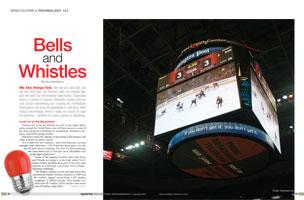
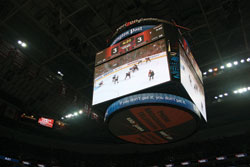 |
| © Lpkb - Dreamstime.com |
We like things fast. We like our cars fast, we eat our food fast, we connect with our friends fast and we want our information even faster. Especially when it comes to sports. Between smart phones and social networking our craving for immediate information can truly be appeased in real time. With today's technology, there's really no reason to wait for anything - whether it's news, scores or standings.
Look! I'm on the Big Screen!
Chances are if you are hosting an event at any larger sports arena around the United States, you will have access to some of the most advanced technology in scoreboards, interactive displays, and LED message boards.
Daktronics leads the industry in providing LED displays and video systems for sports venues.
"It's a relatively new industry," said Fred Doremus, account manager with Daktronics. "All of this has taken place over the last 20 years and it's amazing. The cost of LED technology has come down and it's become more affordable even at the high school level."
"Some of the popular football states like Texas and Florida are using it at the high school level. Some of these facilities are as nice if not nicer than schools at a Division 3 or NAIA level college," Doremus continued.
The Dallas Cowboys set the bar high when they unveiled the Dallas Cowboys Stadium in 2009 and the world's largest center-hung LED display weighing 1.2 million pounds. Each display contains over 10.5 million LED's and the video board uses 30 million light bulbs.
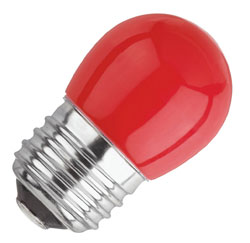 Not to be outdone, the New England Patriots recently announced that they will unleash two new video boards measuring 41.5 feet high and 164 feet wide. These boards will enhance fan experience by providing more instant replays, live statistical updates and out of town scores.
Not to be outdone, the New England Patriots recently announced that they will unleash two new video boards measuring 41.5 feet high and 164 feet wide. These boards will enhance fan experience by providing more instant replays, live statistical updates and out of town scores.
"Most people are looking for the replays," said Doremus. "One of the things we are doing here at Daktronics is we spend a lot of time developing servers that deliver real time data information for sports events."
"It's limitless as far as all the different things that ultimately statistically you can deliver to the fans," he continued. "That information is still important to the fan. It's only your imagination that limits you to what you can deliver the fan and they wouldn't be able to get 10-15 years ago."
But what's the best way to capitalize on technology to make your event stand out?
"We recommend getting in touch with a company like Daktronics, GoVision or Big Screen Network and we are usually able to direct them to rental companies that have bought our displays and utilize them," said Doremus. "They are situated all over the country. People would need a little direction in knowing how to create the content in the right format that would be friendly with the playback equipment but most rental companies can help with that."
WWW.com
It seems as though every facet of our lives is touched by technology.
It's almost 'standard operating procedure' to have event registration online as well as making your travel arrangements and hotel accommodations via the web. But how can the internet truly enhance the event experience for the participants and fans?
TweetMyTime is one of the newest internet tools on the market today. The concept debuted at the 2009 Nationwide Better Health Columbus Marathon.
It was designed by huber+co interactive to provide runner's information to spectators or fans at home without the runner posting times on Twitter or Facebook.
TweetMyTime allows runners to automatically update their progress in real time utilizing a mapping application that the timing company, ChampionChip Minnesota, created.
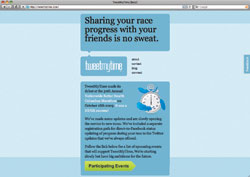 "I thought we might be able to use that data to let runners share their race progress with their followers," said Matt Hornsby of TweetMyTime. "Following the marathon (in 2008) we reworked the programming to allow for better Facebook integration which has proven more popular than the Twitter support."
"I thought we might be able to use that data to let runners share their race progress with their followers," said Matt Hornsby of TweetMyTime. "Following the marathon (in 2008) we reworked the programming to allow for better Facebook integration which has proven more popular than the Twitter support."
The technology has been used by six races to date with runners posting to approximately 6,000 Twitter and Facebook accounts.
"We've intentionally limited our growth to allow us to perfect the service," said Hornsby. "We hope to expand TweetMyTime to more races this fall."
"As social networking becomes increasingly popular, I expect runners will look for more ways to integrate race results into profiles," continued Hornsby. "We're always trying to improve the user experience, both during the sign-up process and on race day. As we work with more races and more runners we're getting a better idea of exactly what they want the service to be; we're trying to bring that to them."
10-4
The iPhone, Blackberry and Droid.
Those are just a few of the multitude of Smart Phones or PDA's that are on the market today that can take photos and video, maintain practice and game schedules and give you the latest scores and updates.
These phones are great for fans and spectators in the sporting world. They allow you to become part of the action through immediate communication like texting and downloading photos and videos.
"Texting is so hot right now," said Doremus. "Utilizing the scoreboard where people have the chance to text a message and win something is huge. Or events can send a message to fans watching the event. They will ask a question from a trivia standpoint and people answer back via text. That's become very popular."
As cool as the smart phone is, it may not be the 'smart' choice for your communication at your event.
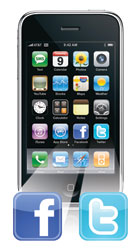 Tom Brewer, with Brewer & Associates, has been in the communications industry for 38 years and has extensive experience in providing communication plans for large events including the last seven Presidential inaugurations, several Olympic Games including the Winter Olympics in Salt Lake City after the attack on the United States on September 11, 2001. The Olympics heightened security and a wide range of secure communication as a result of 9/11.
Tom Brewer, with Brewer & Associates, has been in the communications industry for 38 years and has extensive experience in providing communication plans for large events including the last seven Presidential inaugurations, several Olympic Games including the Winter Olympics in Salt Lake City after the attack on the United States on September 11, 2001. The Olympics heightened security and a wide range of secure communication as a result of 9/11.
"We've had to include an additional ring of security for communication," said Brewer. "That event involved over 96,000 individual items (to include, phones, charger and other accessories)."
Brewer recommends keeping things simple for smaller sporting events and utilizing the professionals for the larger ones.
"If they are going to 100-200, the purchase of FRS (Family Radio Service) radios is cheaper than renting them," said Brewer. "But with larger events we recommend using the commercial radios. Digital trunking is still the best. It's the closest thing we have had to go everywhere and do everything."
Brewer & Associates approaches each event the same. They assess the event by interviewing all the functional groups, determine their needs and write a plan which includes a distribution plan, training, support and a recovery plan.
"Through evolution each event gets better," said Brewer. "The proof of the pudding for an event professional is if you get invited back year after year you know they like what you are doing."
Technology is truly changing the landscape of the sports world.
"From our point of view, technology allows spectators to get more access to information than ever before," said Hornsby. "TweetMyTime relies on external hardware and software to get anything done. If Facebook and Twitter weren't so pervasive it would be much harder for runners to share their race progress with friends. If not for the RFID tags that race timers are increasingly using to efficiently track runner times we wouldn't have anything to post for days after the race was over."
"Two or three years earlier, TweetMyTime wouldn't be possible at all," continued Hornsby. "As GPS and wireless devices proliferate it will be possible to follow athletes in real time, on a run or - I'd predict - on the field or court; perhaps we'll run along beside them from our sofas if we're a little lazy and a little lucky."
So for now, sit back, relax and we'll see what's next.

